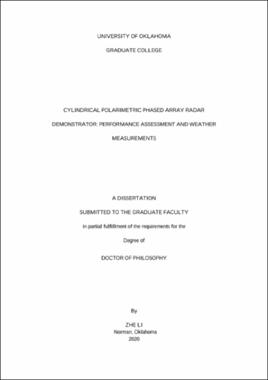| dc.description.abstract | A desirable candidate for future weather observation is a polarimetric phased array radar (PPAR), which is capable of both using polarimetry for multi-parameter measurements and the fast-scan proficiency of the PAR. However, it is challenging to collect high-quality polarimetric radar data of weather with a planar PPAR (PPPAR), whose beam and polarization characteristics change with the electronic beam direction, causing geometrically induced cross-polarization coupling, sensitivity losses, and measurement biases when the PPPAR beam is steered away from the broadside.
As an alternative to PPPAR, the concept of cylindrical polarimetric phased array radar (CPPAR) was proposed, which has scan-invariant beam characteristics in azimuth and polarization purity in all directions using commutating scan, thus enables high quality polarimetric weather measurements. To validate the CPPAR concept, a small-scale CPPAR demonstrator has been jointly developed by the Advanced Radar Research Center (ARRC) at the University of Oklahoma (OU) and the National Severe Storms Laboratory (NSSL) of NOAA.
This dissertation presents the results of initial weather measurements, shows the performance of the CPPAR demonstrator, and evaluates the polarimetric data quality that has been achieved. The system specifications and field tests of the CPPAR demonstrator are provided, including system overview, waveform design and verification, pattern optimization and far-field tests. In addition, three methods of system calibration are introduced and compared, including calibration with an external source, calibration with weather measurements of mechanical scan, and calibration with ground clutter. It is found that calibration with weather measurements of mechanical scan has the best performance and it is applied on the CPPAR demonstrator for the first time, which effectively improved the beam-to-beam consistency and radar data quality in commutating beam electronic scan by minimizing gain and beamwidth variations.
Performance of the CPPAR is assessed through system simulation and weather measurements. The CPPAR is evaluated through an end-to-end phased array radar system simulator (PASIM). The simulation framework, weather returns modeling, antenna pattern, channel electronics, and simulation results of CPPAR, as well as comparison with those that would be obtained with a PPPAR, are provided. Also, weather measurements of a few convective precipitation cases and a stratiform precipitation case made with the CPPAR, employing the single beam mechanical scan and commutating beam electronic scan respectively, are presented. First, a qualitative comparison is made between the CPPAR and a nearby operational NEXRAD. Then a quantitative comparison is conducted between the mechanical scan and electronic scan, and error statistics are estimated and discussed. In addition, a theoretical explanation of a feature of the commutating beam electronic scan in clutter detection that is different from mechanical scan is presented and verified by measurements in clear air conditions with the CPPAR. Moreover, clutter detection results based on multi-lag phase structure function, dual-scan cross-correlation coefficient, copolar correlation coefficient, and differential reflectivity obtained from both electronic scan and mechanical scan modes of the CPPAR are compared. | en_US |
